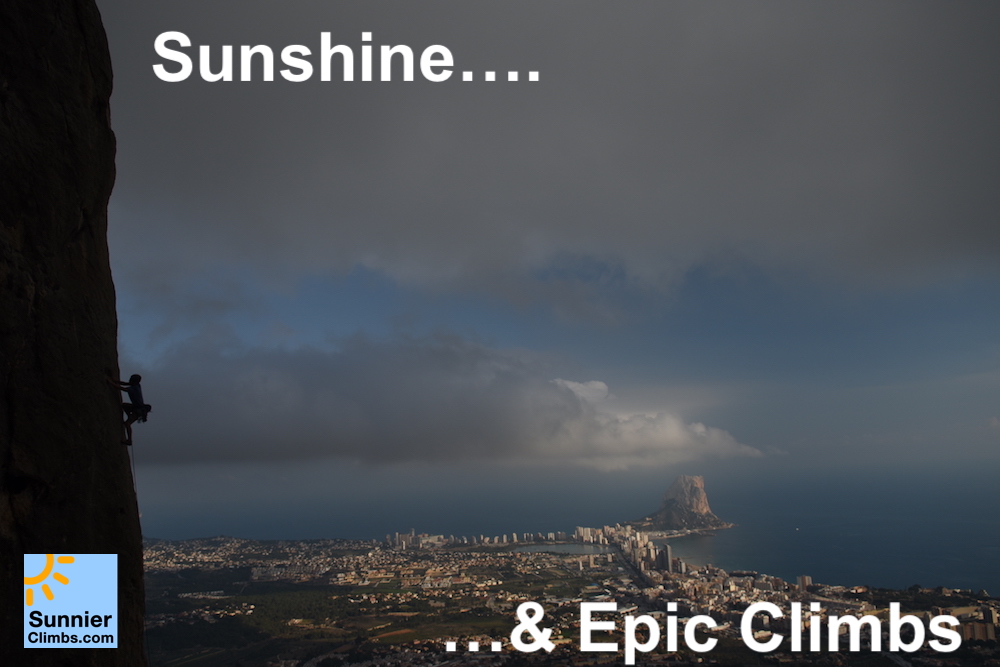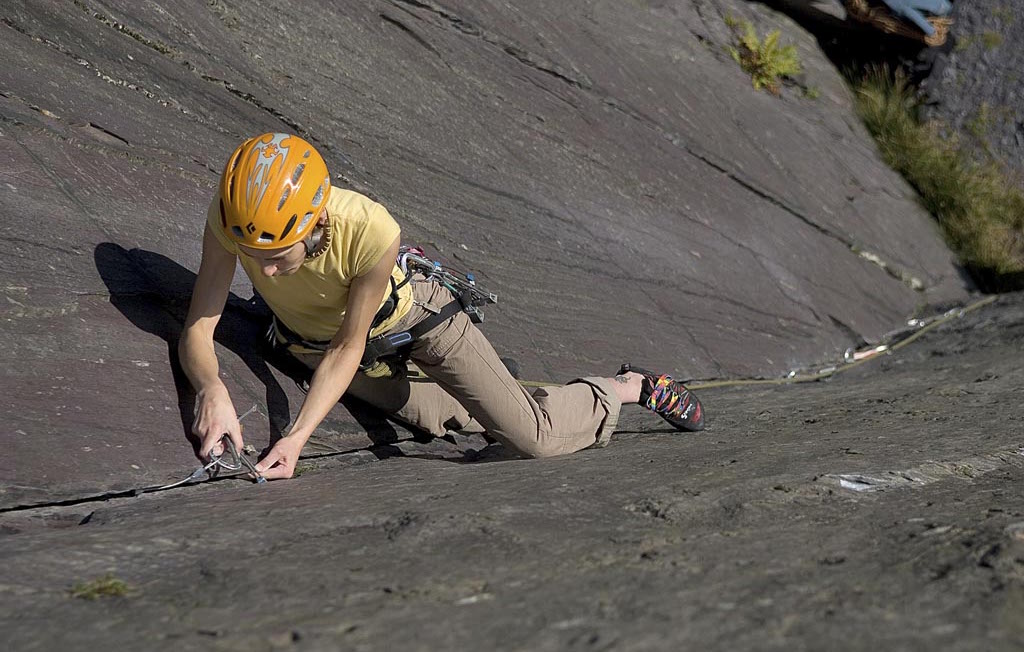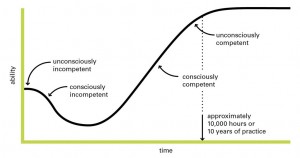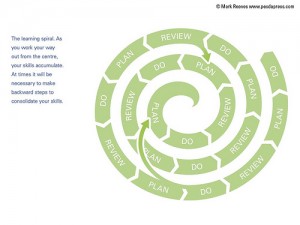Consider how you learn skills which require hand-eye coordination, movement and balance. How did you gained the skills you have like driving a car or riding a pushbike? When you first learnt these skills, they required concentration as well as co-ordination. In the filing cabinet of your mind the instructions for driving were put on file, opened and added to every time you drove. As you progressed things became easier and easier. A few years down the line you have so much practice tucked under your belt that your program file for driving no longer needs your conscious attention at all.
The passage from conscious to unconscious participation is illustrated in the learning curve – the further along that curve, the closer you are to reaching your upper limits of performance.
After trying something for the first time we seem to become worse before we get better. At some point we aren’t as good at a sport as we initially thought. It is at this point of conscious realisation that we can start to piece together what we are doing wrong and make a decision to improve. The pathways we can take to improvement can be a through an informed or an uninformed route.
Practice does not make perfect, only perfect practice makes per- fect – Dr John Fazey
To take driving, most people have lessons (informed) to be taught how to pass the test, but we also gain experience with friends or relatives (uninformed). The informed progression keeps us heading in the right direction (toward becoming legally safe to drive), but it is often the other experiences and extensive practice that really helps us develop.
It takes around one hundred repetitions of a movement to develop muscle memory (unconscious ability) of that specific move. Furthermore, driving or climbing are more than just one or two basic movements. They require you to interact with the real world and to know which techniques to pull from your toolbox for any situation.
It is possible to learn how to drive in an empty car park, but the real skill of driving is learning how to interact with other road users, pedestrians, rain, etc. Likewise in climbing it good to know a series of key movement skills, but it is the ability to pick the right one at the right time that is important. This is the competence that we are aiming to develop, something which might well take ten years or ten thousand hours of practice before you reach your highest level.
To learn a new movement skill we repeat a series of muscular movements and get feedback. After many repititions we lay down movement memory and our nervous system is conditioned to just how hard, fast and long the muscle has to contract or relax. With experience we will have more movement vocabulary to call upon and the more frequently we use them the closer to the front of our ‘ ling cabinet’ the movements will be.
Left to develop these skills on your own can lead to bad technique or lead you down dead ends. The exercises on this site will help to combat this and help you to ‘listen to’ your body as you climb. Efficient climbing comes down to making the right move at the right time, and whilst there are no hard and fast rules, by learning to feel how hard a move is it becomes easier to make improvements to save energy.
Learning isn’t just about trying new things it also requires feedback. What have you learnt? Why you have learnt it? How does that lesson fit into the bigger picture?
In its simplest form the process is Plan – Do – Review. Planning is reading the exercises, watching the videos, looking at the diagrams and thinking about what you are about to do. Doing is the easy part, in doing the exercises our brains are learning things about our bodies and the movement. Review is when we ask ourselves what we have just learnt, good or bad, how we could improve and perhaps where to go next. It is important to allow yourself some time to review your session and review your planned progress.
Bear in mind three things when you practive; try to learn only one thing at a time; keep things simple; discover things for yourself in your own time. Most people can only take on board five to nine pieces of information (7±2 chunks of information) before there is too much information to process.
As part of learning a new skill consider the experience you already have. A gymnast or black belt may not have climbed much rock but they will be be quick to learn because they have learnt to feel their body, they have methods for learning new skills and they have developed balance, flexibility and proprioception. As a climber you bring a vast amount of prior learning to the learning cycle, some of which may be bad technique which will need to be undone. No two people will be the same.
In order for our practice to be most effective for long term learning the practice needs to be varied and random. Don’t train at the same spot on the same things again and again, mix it up in different locations and situations. And by moving location you give yourself some down time from the exercise to process that new information.
Constant repetition during practice will give quick results during your session, but the lessons learnt will fade without breaks to consolidate and think about what you have just done. It is important to take breaks from practice even if it is simply resting whilst a friend climbs, or doing another exercise helping you to forget what you were just trying to learn. This allows you to later recall, reconstruct or even elaborate on the skill you were learning.
Practice needs to be bi-lateral, both left and right or climbing both up and down – variety is the key. Motor skills can be quite specific to each limb (think of kicking a football or riding a snowboard regular or goofy) and varied movement gives greater diversity to our practice and in the long term that vital movement vocabulary.
Learning Summary
- Focus on Efficient and Effective Practive
- Start by repeating skill in isolation
- Move onto repeating the skill is a random and varied
- Allow yourself a break to think and forget about the skill before trying it again.
- Practice things bilaterally (Left/Right, Up/Down)
- Focus on the perfecting the process rather than outcome of a climb.
- Use your warm-up at the start of your session to remind you of what you learnt last time.



